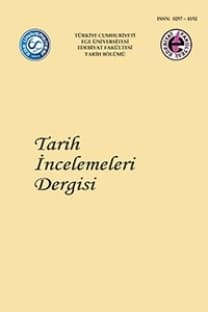Vladimir Meryem ana tasviri menkıbesi ve Timur Beg'in rüyası
ladimir Meryem Ana tasviri eski Rusya'da milli bilincin en önemli sembollerinden biri idi. Tarihçiler Moskova'nın gücünü tanımlarken ortaçağ Rus siyasî düşüncesinde Bizans tesirini vurgulayıp çoğunlukla bu tasvirin ehemmiyetini görmezden gelmektedirler. Ayrıca bu ikonanın öneminin 1395 yılındaki Timur istilasına ait eski bir hikâyeden kaynaklandığı düşünülmektedir. Metropolit Makariy, 1547 yılında Çarlık tacını giyen IV. îvan'm emperyal iddiasını güçlendirmek için efsanelerin büyük bir bölümünü yeniden tasarlayıp, geliştirerek kaleme almış ve devlet politikasını derinden etkilemiştir. Vladimir Meryem Ana ikonu Kremlin sarayında itibar gören bir sembol olarak kalmış ve XVI. Yüzyılın sonlarında, Rurik Hanedanının son bulmasının ardından da Rusya'nın emperyalist ve milli hedeflerinin sembolü olmuştur.
Legend of the icon of Our Lady of Vladimir and dream of Timur Beg
The icon of Our Lady of Vladimir was one of the most important symbols of national consciousness in old Russia. Historians have noted the Byzantine influence in descriptions of Muscovite power and largely ignored the value of the icon in mediaeval Russian political thought. İt is considered that the importance of the icon is derived from old tales about the invasion of Tamerlane in 1395. Metropolitan Makarii developed the legend as part of a major rewriting of texts designed to sustain the imperial pretensions of Ivan IV, whom he crowned as Tsar in 1547, and to influence state policy. The Vladimir icon of Our Lady remained in the Kremlin as a popular symbol of the substance and the continuity of Russian imperial and national aspirations long after the dynasty of the Rurikides died out at the end of the sixteenth centuiy.
___
- Aka 1991 İsmail Aka, Timur ve Devleti, Ankara.
- Bay dur 1982 Nezahat Bay dur, İmparator Iulianus, İstanbul.
- Gregory 2008 Timothy E. Gregory, Bizans Tarihi, Çev: Esra Ermert, İstanbul.
- Kalavrezou 1990 Ioli Kalavrezou, "Images of the Mother: When the Virgin Mary Became "Meter Theou", Dumbarton Oaks Papers, Vol.44, 165-172.
- Kenna 1985 Margaret E. Kenna, "Icons in Theoiy and Practice: An Orthodox Christian Example", History of Religions, Vol. 24, No. 4, 345-368.
- Köprülü 1937 Fuad Köprülü, "Yıldırım Bayezıd'ın Esareti ve İntiharı Hakkında", Belleten, 1/2, 591-603.
- Köroğlu 2006 Kemalettin Köroğlu, Eski Mezopotamya Tarihi Başlangıçtan Perslere Kadar, İstanbul.
- Kurat 1999 Akdes Nimet Kurat, Rusya Tarihi Başlangıçtan 1917 'ye Kadar, Ankara.
- Lasareffl938 Victor Lasareff, "Studies in the Iconography of the Virgin", The Art Bulletin, Vol. 20, No. 1, 26-65.
- Miller 1968 David B. Miller, "Legends of the Icon of Our Lady of Vladimir: A Study of the Development Muscovite National Consciousness", Speculum, Vol. 43, No. 4, 657-670.
- Olsufiev 1930 Yoori A. Olsufiev, "The Development of Russia Icon Painting from the Twelfth to the Nineteenth Century", The Art Bulletin, Vol. 12, No. 4, Dec., 347-373.
- PSRL(6) 1853 Polnoe Sobranie Russkih Letopisey (6), Sofiyskaya Letopisi, St. Petersburg.
- PSRL(11)2000 Polnoe Sobranie Russkih Letopisey (11), Letopisniy Sbornik îmenuemıy Partiarşey ili Nikonovskoy Letopisyu, Moskova.
- PSRL (15) 2000 Polnoe Sobranie Russkih Letopisey (15), Rogojskiy Letopisets Tverskoy Sbornik, Moskova.
- PSRL (26) 1959 Polnoe Sobranie Russkih Letopisey (26), Vologodsko Permskaya Letopis, Moskova-Leningrad.
- Rice 1935 D. Talbot Rice, "The Origins of Russian Icon Painting", The Burlington Magazine for Connoisseurs, Vol. 67, No. 388,36-41.
- Shevzov 2000 Vera Shevzov, "Icons, Miracles and the Ecclesial Identity of Laity in Late Imperial Russia Orthodoxy", Church History, Vol. 69, No. 3, 610-631.
- Weitzmann 1966 Kurt Weitzmann, "Byzantine Miniature and Icon Painting in the Eleventh Century", Thirteenth International Congress of Byzantine Studies, Oxford, 1-18 (Ayrı Basım).
- ISSN: 0257-4152
- Başlangıç: 1983
- Yayıncı: Prof. Dr. Süleyman Özkan
Sayıdaki Diğer Makaleler
Yerel kayıtların ışığında XVIII. yüzyıl sonlarında İzmir
Osmanlı Devleti’nin 1917 Yılı Yabancı Nüfusu
Osmanlı Devleti’nde Şeker Fabrikası Kurma Teşebbüsleri
Dönemin Arap kaynaklarına göre "Ankara Savaşı"
Türkmen şehri Musul'un geç ortaçağdaki fiziki yapısı üzerine bir değerlendirme
Ortaçağ Ermeni Kaynaklarına Göre Selçuklu Sultanları
Aydınoğlu İsa Bey: Bir Bani, üç cami
Türkmen Şehri Musul’un Geç Ortaçağdaki Fiziki Yapısı Üzerine Bir Değerlendirme
Vladimir Meryem Ana Tasviri Menkıbesi ve Timur Beg’in Rüyası
